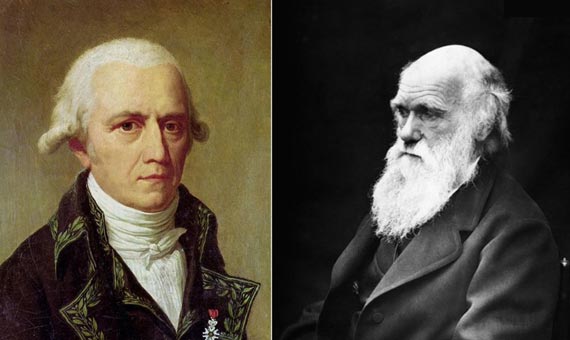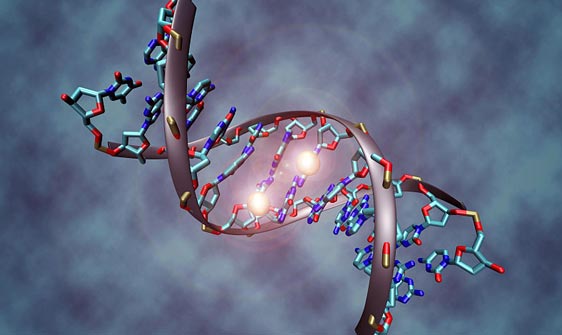Much of the population has this idea of biological evolution: species change by the need to adapt to the environment, and this process of change often depends on the use (or lack thereof) of certain body parts. In a classic example, the giraffe’s neck would be stretched by the need to reach the leaves in the treetops. The problem with this idea, which according to several surveys is fairly widespread, is that it is erroneous – it does not correspond to the theory developed by Darwin, which has to a great extent influenced our current understanding of evolution.

This concept, which continues to thrive today in the popular imagination, is actually pre-Darwin. It comes from the vision of Frenchman Jean-Baptiste Lamarck (August 1, 1744 – December 18, 1829), a naturalist who made great contributions to the field of taxonomy. He coined the term “invertebrates” and the division of this group into ten categories. But perhaps he is remembered today more for the theory that he first presented at a conference on May 11, 1800, according to which there is a natural force that compels species to progress to more complex forms. During the process, species were thought to change to adapt to their environment; the eyes of moles atrophied from lack of use, and this change was passed on to their offspring. In short, Lamarck’s theory was based on two ideas – adaptive change and the inheritance of traits acquired during an individual’s life. This latter idea already formed part of the thinking of other naturalists of his time.
Half a century later, the theory of natural selection of random variations, introduced by Darwin, annihilated the idea of adaptive mutation. In the late nineteenth century, August Weismann refuted the inheritance of acquired traits, proposing that changes in somatic cells did not affect inheritance, dependent only on the germ cells such as the sperm and the egg. Thus, no matter how much a giraffe’s neck stretches, this elongation will never be transmitted to its offspring, as it leaves no mark on the animal’s sperm or eggs.
The scientific resurrection of Lamarck
And yet, despite everything, in recent decades there have been new discoveries that have resuscitated Lamarck’s ideas for part of the scientific community. In the late twentieth century it began to be understood that certain other acquired traits could actually be inherited; for example, food or the exposure to pollutants can print chemical marks on DNA capable of overriding the expression of a gene. These modifications do not change the genetic sequence, but since they are attached to the DNA molecule they can be transmitted to offspring if they affect germ cells. Consequently, the functioning of a gene of an individual may actually be altered because of something that his father ate. These features are called epigenetic, and for some biologists they suggest a demonstration of the inheritance of acquired characteristics, which has inspired a Neo-Lamarckism revival.

However, other experts question whether epigenetic traits really correspond to the model of Lamarck; in principle they are not adaptive changes due to the efforts of an individual, like “a pianist learns a sonata and her child inherits the ability,” as David Haig, an evolutionary biologist at Harvard University (USA), explains to OpenMind. Therefore, speaking of Lamarckian inheritance is, for Haig, “a semantic morass” because it depends on the definition of each word.
Inheritance of acquired traits from random mutagenesis
Because this adaptive nature is lacking, “it is impossible to separate entirely the inheritance of acquired traits from random mutagenesis,” opines Adam Weiss, a researcher at the University of Vienna (Austria). Meanwhile, Haig gives a relevant example: a lack of folate in the diet may cause epigenetic change, while a mutagen in a food can alter the DNA sequence. Both have the same origin (diet) and both are inherited, but which is Lamarckian inheritance and which responds to the pattern of random variation described by Darwin? What is important, say scientists, is how evolution works over the long term. And, in this regard, says Haig, epigenetic changes are there because they are also “a product of Darwinian natural selection.”
In addition to epigenetics, there is another recently discovered phenomenon in which some experts see the shadow of Lamarck. Many bacteria possess an immune mechanism called CRISPR, whereby a microbe can incorporate into its own DNA the genetic fragments of an invading virus, in order to recognize it and respond to it on future occasions. This immunity is acquired, is adaptive and is transmitted to offspring. For evolutionary biologist William F. Martin of the Heinrich Heine University of Düsseldorf (Germany), the CRISPR system is “exactly what Lamarck had in mind; it is an example in biology that fits the mechanism he predicted. […] Acquired immunity in a real sense. Closed case,” said Martin to OpenMind.
Nevertheless, for Martin this does not mean that the view of evolution as a whole should move even one iota from Darwin towards Lamarck: “Lamarck was not right, because nearly all of evolution proceeds as Darwin thought.” Haig agrees that one thing is that Lamarckian inheritance exists, but it is quite another thing that this is the engine of evolution. He explains that it is all about the different time scales: “On a short-time scale the system could be considered Lamarckian (under some definitions) but its long-term evolution is Darwinian.” In short, and according to what Weiss wrote in a recent article published in the journal Trends in Ecology & Evolution, “Bringing back Lamarck is unjustified and misleading.” Lamarck was “an interesting guy with an interesting theory,” concludes Martin, but he was also “unlucky.”
Comments on this publication